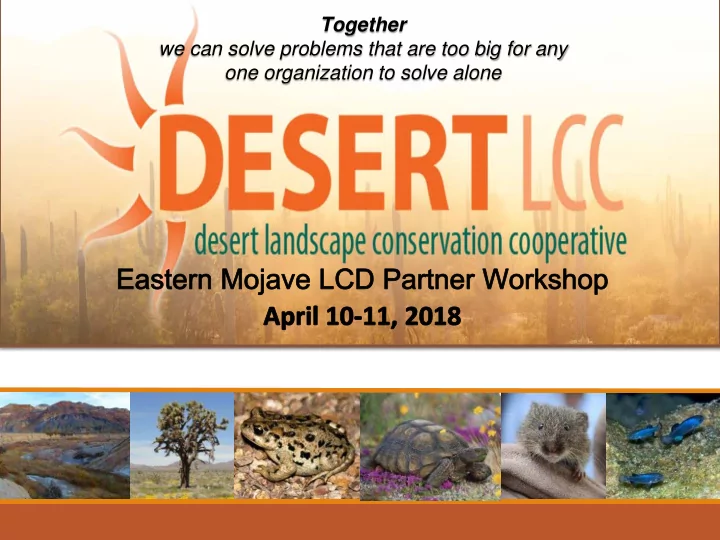

Together we can solve problems that are too big for any one organization to solve alone
Eastern Mojave LCD Coordinating Team • Desert LCC Team: Genevieve Johnson – Bureau of Reclamation • Matt Grabau – US Fish and Wildlife Service • Colleen Whitaker – Southwest Decision Resources • • Brian Croft – West Mojave Desert Division, USFWS • Roy Averill-Murray – Desert Tortoise Recovery, USFWS • Jennifer Wilkening – Southern Nevada Fish and Wildlife Office Flo Gardipee – Southern Nevada Fish and Wildlife Office • • Rose Banks – California Department of Fish and Wildlife • Jenn Newmark – Nevada Department of Wildlife • Sandra Brewer – Bureau of Land Management • Heidi Calvert – California Department of Fish and Wildlife James Hurja – US Forest Service • • Josh Hoines – National Park Service • Kevin Wilson – National Park Service • Gerry Hillier – Quadstate Local Governments Authority • Bill Lamb – Quadstate Local Governments Authority • Lara Kobelt - BLM 2
Landscape Conservation Designs Identify, develop and strengthen large-scale collaborative relationships. Identify common resource and social values, and establish and achieve specific goals. Specific goals & objectives
Landscape Conservation Designs Identify, develop and strengthen large-scale collaborative relationships. Identify common resource and social values, and establish and achieve specific goals. Produce information and tools needed by partners to meet common goals Possible Future Conditions Build on existing Scenario Assess current work planning conditions
Landscape Conservation Designs Identify, develop and strengthen large-scale collaborative relationships. Identify common resource and social values, and establish and achieve specific goals. Produce information and tools needed by partners to meet common goals. Rely on partners to implement actions within their authorities that collectively contribute to conservation goals Design where actions Identify suite of Monitor & Revise best meet goals adaptation strategies
Desired Landscape Conservation Design Outcomes Clearly define common goals and objectives Map priority ecosystems & assess their current condition Collectively identify adaptation and conservation actions Integrate Scenario Planning to prioritize where conservation actions will be effective Identify partner activities to ensure integrated effort Measure success using common language & methods
Goals & Objectives for the Desert LCC Biodiversity • Connectivity • Ecosystem Integrity • Socioeconomic Resources • Cultural Resources • 7
Eastern Mojave Pilot Area • One of three pilot areas within the Desert LCC • Multiple stakeholders interested in collaborative conservation • Areas: The Eastern Mojave Recovery Unit of the Desert Tortoise Recovery Plan & overlapping Amargosa River watershed
THE EASTERN MOJAVE CONSERVATION COLLABORATIVE
Key characteristics of the area 1 of 5 recovery units for the Mojave Desert Tortoise 2 areas of high endemism and T&E species: Amargosa River Basin and Spring Mountains Seeps, springs, streams in unique desert area
Strategic Outreach: Preliminary input from Eastern Mojave partners Key Resource Issues • Groundwater • Wildlife linkages • Invasive species Land Use Plan Implementation • Integrate plan implementation across the state line • Site-specific management actions to step land use plans down to a local level • Link priorities between land use plans to identify areas of consistency and synergy • Funding is limited
Goals and objectives Promote effective collaboration by leveraging resources to achieve lasting conservation outcomes in the Eastern Mojave Desert In order to do this we aim to…..
Key points for Eastern Mojave Conservation Collaborative Develop critical information to support management actions Implement an action-oriented process that focuses on implementation rather than simply producing more planning documents Strengthen and/or develop ongoing forums and partnerships for coordination and collaboration Work for shared leadership and the development of shared funding
Comments from LCD Partners Roy Averill-Murray – Desert Tortoise Recovery, USFWS 15
Why BLM is supporting Eastern Mojave LCD Boris Poff – Southern Nevada District, Bureau of Land Management BLM does not perform or attempt to perform the same management activities that state water regulatory entities perform. BLM considers water, both surface and groundwater, within the broader context of all resources on BLM administered lands and their interaction as they relate to BLM responsibilities. … how BLM land use decisions may affect groundwater resources, and taking steps to ensure that those decisions minimize negative impacts to those resources. The allocation of water for activities, such as development, mining and power generation, is a state function, the prevention of adverse environmental impacts from these BLM authorized uses is an agency responsibility as required by the National Environmental Policy Act. 16
Eastern Mojave Timeline Draft goal and objective Outreach statements, compile Establish Webinars potential indicators, Coordinating develop analysis process Team Nov. 2017 Presentations & outreach Engage key partners Work with UA spatial for input on goals, analysis team, SW CSC objectives and focal scenario planning team, resources and case studies writers 17
Eastern Mojave Timeline Develop and finalize ecosystem integrity Conservation Scenario Plan indicators Blueprint 1.0 Development Refine biodiversity goals Refine Apr. 2018 connectivity Develop goals Spatial Prioritization Ongoing: Develop Discuss social, Tool CCAST Management cultural and Toolbox economic aspects of LCD 18
Questions on Landscape Conservation Design? Genevieve Johnson Julia Sittig US Bureau of Reclamation Facilitator gjohnson@usbr.gov Southwest Decision Resources julia@swdresources.com Matt Grabau Science Coordinator US Fish and Wildlife Service matthew_grabau@fws.gov Colleen Whitaker Project Lead Southwest Decision Resources colleen@swdresources.com
Recommend
More recommend